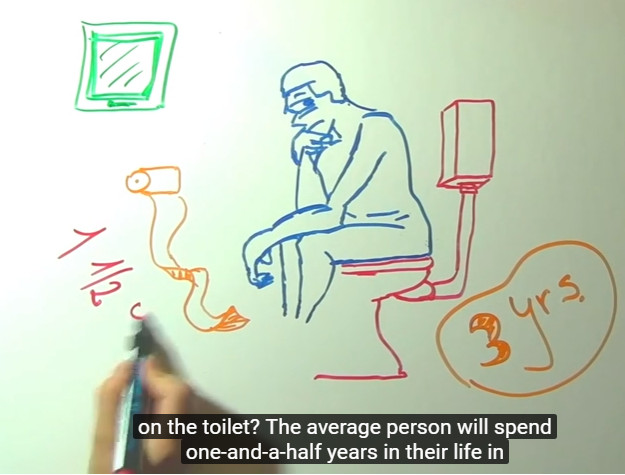The funny history of the toilet
 |
film video internet Jun 2014 ; Durée: 9 min.
Ed. Action Brainiac -
Téléchargeable chez l'éditeur
Abstract:
Did you know that you spend up to 3 years of your lifetime on the toilet? Or that that more people in the world have mobile phones than toilets?
Join me for a quick trip through the history of the toilet, as early as 3000 B.C.!
Did you know that you spend up to 3 years of your lifetime on the toilet? An average person will spend 1 1/2 years of their lifetime in the bathroom. Women spend an average of 1 year, 7 months, and 15 days longer in the bathroom than men. However, men spend more time on the toilet than women do (an hour and 45 minutes every week, compared to an hour and 20 minutes a week for women).
Whatever you may choose to call it, powder room, lavatory, outhouse, washroom, dunny, restroom, latrine, water closet (WC), john, can, crapper or even House of Honor, the toilet is one of the most time-consuming aspects of our lives.
That is quite funny actually, considering that more People In The World Have Mobile Phones rather Than Toilets. 1 billion people still defecate in the open, in the absence of a toilet and, according to the United Nations, 2.6 billion people still lack indoor toilet facilities, particularly in rural areas of China and India.
Just think about it! You now have the privilege of playing Candy Crush on your indoor can, but… Where did it all come from? Which primitive individual first had the idea of sitting on a toilet?
Cultures as far back as 3000 BC were flushing away within their own improvised systems of moving water around. Many sources cite ancient Crete’s King Minos (18th century B.C.) as having the world’s first flush toilet, but members of the Harrappa civilization, in what is now India, had toilets in their homes that drained into subterranean clay chambers. The people in Skara Brae, a 31st century BC settlement in what’s now Scotland, even had the idea to use a draining system in combination with a nearby river in order to automatically sweep out their dirty business.
A few thousand years later, the Romans were masters in flushing away waste. Massive aqueducts brought massive volumes of fresh water into Roman cities. Rome’s famous public baths were well stocked with urinal-style toilets that drained into its meticulous sewage system, but private bathrooms were a rarity reserved for the wealthy.
Well, once the Roman empire fell, the idea of public sanitation fell with it. The entire world didn’t go any further ,for quite a few centuries, than using the traditional chamber pot, the most low-tech approach for the most low-tech era when European city dwellers casually threw the contents into the public streets where they mixed with horse droppings.. If you think today’s cities smell bad, just imagine London, Paris or Prague in the 16th century!
It wasn’t until 1596, when a man named John Harrington published his own manual for the assembly of the first flush toilet, a simple idea of combining a mechanical valve and a tank of water, the two basic components that are still found today in our modern “thrones”.
From that point onwards, the history of toilets was marked by small enhancements, such as the constant pool of water developed by Alexander Cummings in 1775 so to finally prevent bad smells. 18th century inventors refined the flushing mechanism and flow of water, whereas their 19th century successors added better drainage and valves that (thankfully) leaked less. English plumber Thomas Crapper, ridiculed for his name as you may have guessed, did much to popularize the private flushing toilet in Europe, leading many to falsely believe he invented it. The only great toilet innovation of the 20th century was that of integrating the water tank into the seat itself, rather than attaching it to a wall. Beyond that, a hundred years of slight tinkering haven’t advanced the basic design one bit, just created variations for the main design.
Mots clefs: |
rites et cultures (CI) (DT) (OP) (ope) , toilettes, latrine (CI) (DT) (OP) (ope) |
Editeur/Diffuseur: |
|
Action Brainiac - - Etats Unis |
En cas de lien brisé, nous le mentionner à communication@pseau.org